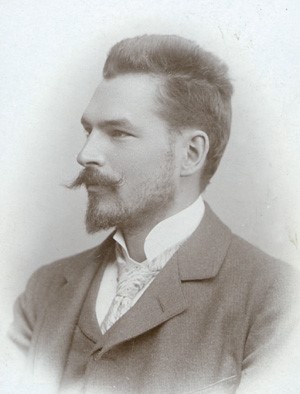Marian Smoluchowski
 Year 2017 is 100 anniversary of Marian Smoluchowski’s death. One of the most outstanding physicists of the beginning of the XXth century was born in Vorderbrühl, Habsburg Empire in 1872 and for the first 27 years of his life, including education and early scientific career, he was connected with the city of Vienna where he attended the prestigious, selective secondary school Theresianum and graduated from the University of Vienna. After receiving PhD diploma in 1894, he continued studies in Paris, Glasgow and Berlin.
Year 2017 is 100 anniversary of Marian Smoluchowski’s death. One of the most outstanding physicists of the beginning of the XXth century was born in Vorderbrühl, Habsburg Empire in 1872 and for the first 27 years of his life, including education and early scientific career, he was connected with the city of Vienna where he attended the prestigious, selective secondary school Theresianum and graduated from the University of Vienna. After receiving PhD diploma in 1894, he continued studies in Paris, Glasgow and Berlin.
In 1899, at the age of 28, Smoluchowski was offered and accepted a chair in Theoretical Physics at the University of Lvov. The time spent there contributed substantially to his creative power and inventiveness. In July 1906 his famous paper about Brownian motion was published. Together with the former (and conceptually different) description published by Einstein in May 1905, those two scientific articles paved the breakthrough in understanding of the atomistic structure of matter. Soon after, Smoluchowski demonstrated that the density fluctuations in the air affect local changes in the refraction coefficient and are responsible for light dispersion in the atmosphere. In 1908 he proposed the theory of critical opalescence which explained unusual intensity of the fluctuations close to the critical point. His broad scientific interests covered also applications of the theory of probability to radioactive decay, heat conductivity of gases, ionization of gas molecules, aerodynamics and glacial formation. Perhaps one of the most fundamental achievements of Smoluchowski was probabilistic analysis of the Second Law of Thermodynamic1 addressing nature of irreversibility in macroscopic phenomena and clarification of the ergodic hypothesis of Boltzmann.
In 1913, as already a world-renown scientist, Smoluchowski decided to move to Kraków to take over the chair after August Witkowski in the Department of Experimental Physics, Jagiellonian University. Three year later he became a dean of the Faculty. In appreciation of his scientific work and his commission to promote science as a Faculty member and an academic (Smoluchowski was a member of the Academy of Knowledge), in 1917 he was elected the Rector of the Jagiellonian University. His premature death on September 5, 1917 did not allow him neither to take up the duties, nor to deliver the inaugural lecture “On the uniformity of laws of Nature” which he prepared for the opening address of a new academic year.
Smoluchowski’s scientific output is considered until today as a part of most influential work on the kinetic theory of matter, theory of fluctuations and formal development of statistical physics and theory of random processes.
As Mark Kac wrote2: “... while directed toward the same goal how different the Smoluchowski approach is from Boltzmann’s. There is no dynamics, no phase space, no Liouville theorem — in short none of the usual underpinnings of Statistical Mechanics. Smoluchowski may not have been aware of it but he begun writing a new chapter of Statistical Physics which in our times goes by the name of Stochastic Processes. It is the probabilistic point of view in contradistinction to the statistico-mechanical one that is also clearly present in Smoluchowski’s first paper on Brownian motion3 and in a paper on the mean free path which just preceded it.4 This is a remarkable paper in which as far as I know the relation between random walk and diffusion is first established (L. Bachelier who is usually credited with this discovery comes a little later). Equally remarkable is the fact that Smoluchowski uses here Fourier transforms to handle convolutions of probability distributions and is thus first to prove a special case of the central limit theorem of probability theory by means of characteristic functions. The novelty and originality of the Smoluchowski approach lie in his bold replacement of an impossibly difficult dynamical problem (a Brownian particle in a gas or liquid) with the statistical element coming in through the lack of specification of the initial state by a relatively simple stochastic process. A dynamical event like a collision, for example, is thus treated as if it were the result of a toss of a coin or a die with the laws of mechanics determining (to some extent at least) the probabilities of various outcomes. The underlying idea proved enormously fruitful and it gradually permeated much of statistical physics; permeated it, in fact, so well that few of us realize today that much of „modern” problematics (notably that related to so called master equations) is directly traceable to ideas first promulgated by Smoluchowski in the early years of this century” .
1 M.Smoluchowski, Experimentell nachweisbare, der üblichen Thermodynamik widersprechende Molekularphänomene, Phys. Zeitschrift 1912, 13, 1069–1080
2 Mark Kac, Marian Smoluchowski and the evolution of statistical thought in physics, In: Marian Smoluchowski, His Life and Scientific Work, Polish Scientific Publishers PWN, Warszawa 1999
3 M. Smoluchowski, Bull. Int. Acad. Sci. Cracovie, 477 (1906); M. Smoluchowski, Ann. Phys. 21, 756 (1906).
4 M. Smoluchowski, Bull. Int. Acad. Sci. Cracovie, Cl. Sci. Math. Nat. 202 (1906)